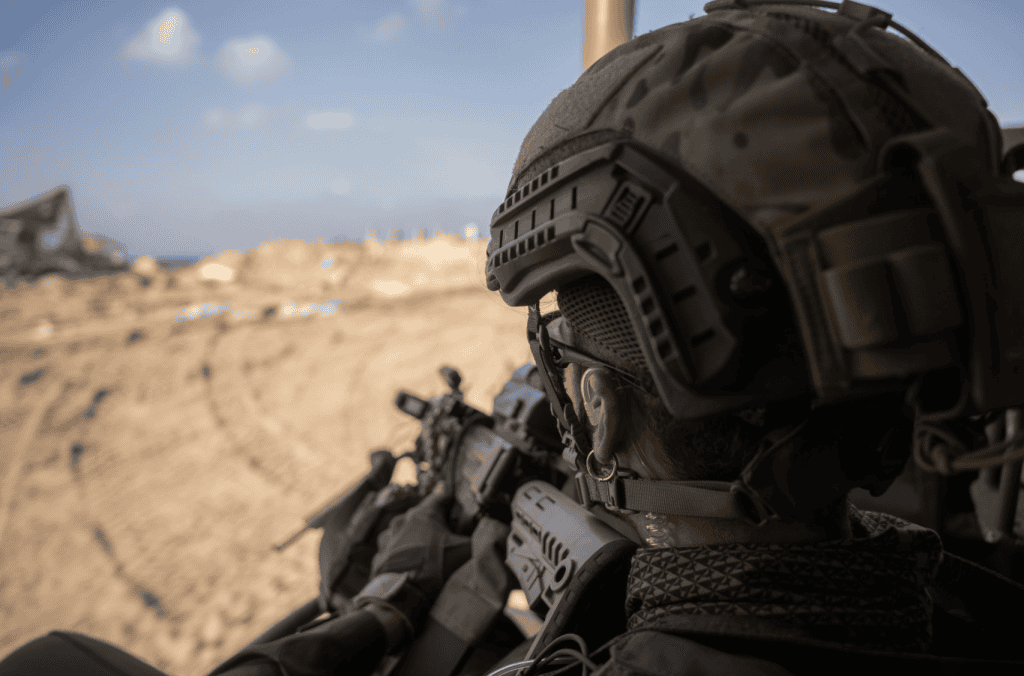
On December 5 as Hamas continued to fire rockets at Israeli cities, the IDF expanded operations in Gaza to include Khan Younis, the hometown of Hamas leader Yahya Sinwar. The day, which included extreme thunderstorms across Israel, saw IDF troops fighting in two cities in the Gaza Strip: Gaza City in the north and Khan Younis in the south. IDF spokesperson Rear Admiral Daniel Hagari said on December 5 that Israel has struck more than 20,000 targets in Gaza and eliminated an estimated 6,000 Hamas terrorists since the war began.
On Tuesday, IDF Chief of Staff Herzi Halevi put out a long statement detailing the IDF’s operations in Gaza and other important issues. He focused on the renewal of fighting over the last few days. “60 days after the war began, our forces are now encircling the Khan Yunis area in the southern Gaza Strip,” he said. “Many Hamas operatives, including senior commanders, have been eliminated in recent days. We have moved to the third phase of the ground operations.” The IDF’s commander of Southern Command, Major General Yaron Finkelman, also described the Gaza fighting as taking place in three key areas on Tuesday: “the heart of Jabalya, in the heart of Shujaiya, and now also in the heart of Khan Yunis.” Jabalya and Shujaiya are neighborhoods north and southwest of Gaza city, respectively. Finkelman described the battles on December 5 as among the most intense days of battle since the ground operation began on October 27. The IDF entered Khan Yunis on November 24 once fighting resumed after a week-long pause.
The IDF emphasized in statements on Tuesday that it continues to operate in Jabalya, an urban and densely populated neighborhood north of Gaza city. “Over the past day, IDF troops operated in Hamas strongholds and destroyed terrorist infrastructure in the area. During the activity, the IDF took control of key military posts from which attacks on IDF troops have been carried out,” the IDF said. The Israeli forces also conducted a raid on a Hamas command and control center in Jabalya.
In the neighborhood of Shati, which is on the Mediterranean Sea in the north of Gaza, the IDF continued to investigate and locate Hamas terrorist infrastructure. A video released by the IDF showed a commander of the IDF Nahal Brigade operating in this area and was intended to illustrate how Hamas uses civilian areas. In the video, the officers show how weapons were found in schools and a densely populated civilian area. Much of the population of these areas fled south over the last month. Israel has been warning Gazans to flee areas of fighting.
Finkelman also said that since the offensive began again in Gaza, the Israeli Air Force has carried out “two rounds of strikes involving dozens of aircraft from all the combat squadrons.” He described how the IDF was continuing to use two large divisions, the 36th and 162nd, that combine infantry and tanks to pressure Hamas fighters in Jabalya and Shujaiya. He called this a “multi-front” operation, noting the 36th was concentrating firepower on Shujaiya, and the 162nd was focusing on Jabalya.
Halevi described the war in Gaza as one of precision that used combined arms to strike at Hamas. He emphasized that the IDF was evacuating the civilian population from combat zones, a reference to IDF warnings given to civilians. He noted that the IDF is using a large amount of firepower against Hamas: “Striking them requires significant use of fire, both to target the enemy but also to, of course, protect our forces. Therefore the forces operate powerfully, while making big efforts to mitigate as much as possible harm to civilians.”
Halevi also provided an update on tensions in northern Israel. He said that Hezbollah chose to renew attacks on Israel when the pause in fighting ended in Gaza. Since December 1, there have been numerous attacks in the north. “We are exacting a high price from Hezbollah, one that it is trying to hide,” he said.
I drove to northern Israel on December 5 to observe the situation near the border. The IDF called up more than 300,000 reservists in the wake of the Hamas attack on October 7 and has kept significant forces in northern Israel in case of a conflict with Hezbollah. Israel also evacuated more than forty border communities in the north in October. Hezbollah has carried out numerous attacks on these communities. For instance on December 5, there was a rocket launch near the border community of Zarit. The IDF said it struck the sources of the fire. A drone was also detected in another area along the border. There were also sirens in the area of Kiryat Shmona and Metulla near Lebanon. The use of munitions from training and from the low-level conflict along the border could be heard during the day.
Israel also continues to face threats from the West Bank. According to a December 5 update on operations in the West Bank, Halevi said the IDF has frequently carried out raids and arrests against terrorists there since October 7. He said that Israel is now “increasing the fight against terrorism,” in the West Bank. “In the last two months, over 1,200 Hamas operatives were apprehended in Judea and Samaria, many terrorists who carried out attacks, some very serious attacks in the past, some that were planning to carry out future attacks,” he said.
Israel released 240 Palestinian prisoners and detainees during the pause in fighting with Hamas. The prisoners were released in exchange for hostages held in Gaza. Some of those Palestinians returned to the West Bank. The IDF said on December 5 that Hamas holds 138 hostages in Gaza. In addition, 408 IDF soldiers have been killed in fighting since October 7.







